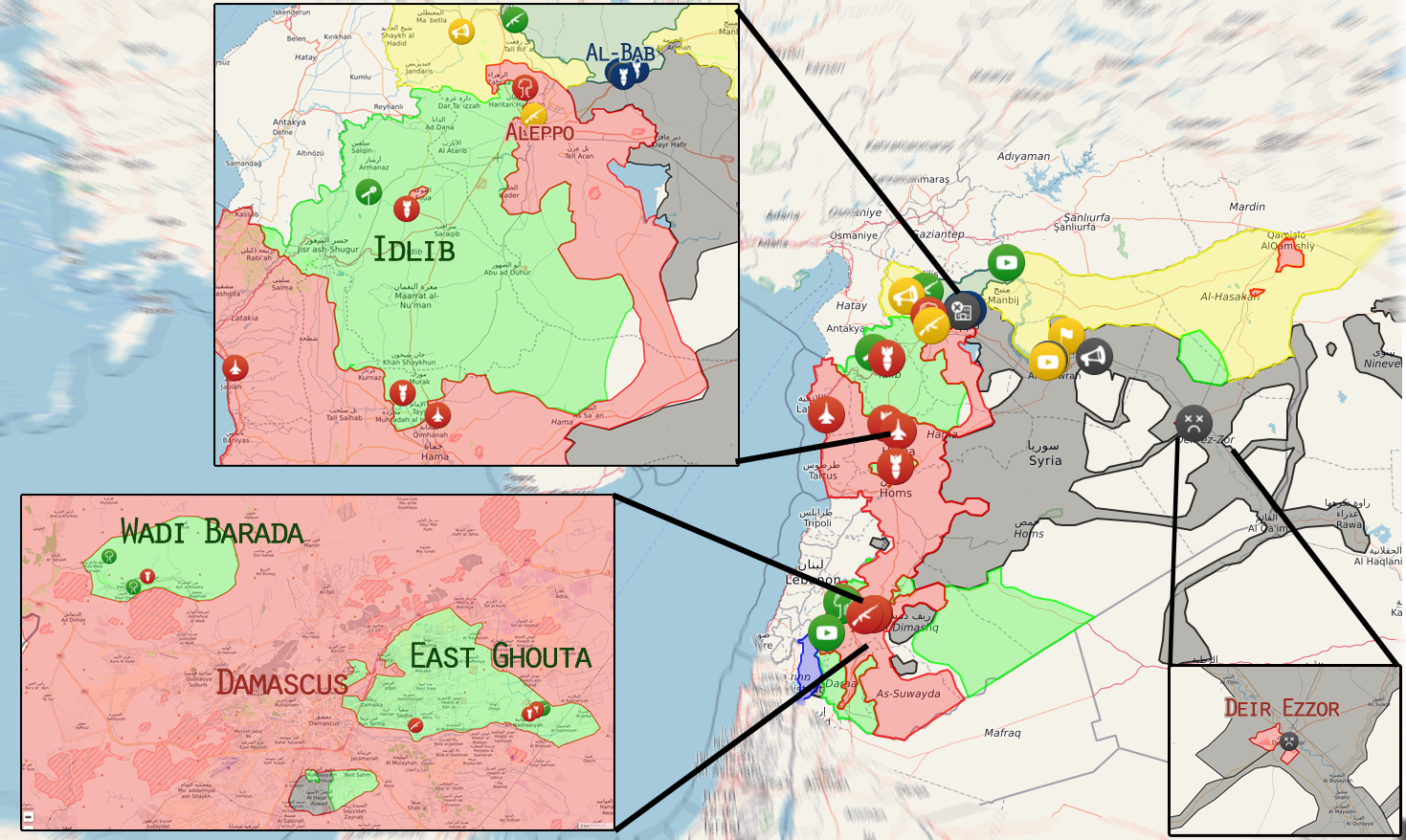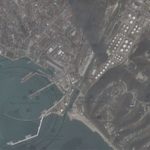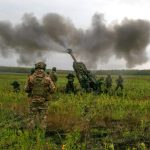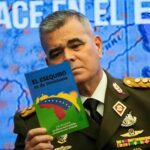STRATEGIC FORECAST – Reflecting on the Syrian Civil War’s end of the year and debut of 2017 I have outlined the following scenarios. The analysis consists of a procedural process of summarizing the context, deepening into present tendencies and outlining the prospects. Sources are as always, Open (OSINT) gathered through social media crowd-sourcing and personal empirical and holistic conclusions.
Executive Summary
The end of 2016 has had several swift and tide-turning developments through-out the battlefield that wages-on since 2012. The focus locations of these major breakthroughs have been:
- Aleppo: where the Loyalists Coalition comprised of the Syrian Arab Army, Russia Armed Forces, Iranian Revolutionary Guards, Lebanese Hezbollah and other non-state actors, such as local Shi’a militias have managed to expel the Opposition/Rebels that have been under a heavy siege in the eastern part of the town for several months.
- Raqqa Governorate: Syrian Democratic Forces (SDF) led and dominated by the Kurdish YPG/YPJ have launched operation “Wrath of Euphrates” with the main objective of carving ground towards the ISIS self-proclaimed capital of Raqqa[1]. The SDF is supported by the US-led Coalition Joint Task Force “Inherent Resolve” by air strikes and limited special operations ground assets.
- Northern Syria/ Aleppo Governorate: The Turkish led-operation “Euphrates Shield” spearheaded by Rebel factions is continuing to carve through ISIS-held territory after it ousted the terror group from its border and also denied a direct link between the Kurdish western canton of Afrin and the ones east of the Euphrates. After liberating 100 km wide of border territory and digging 35 km south, the Turks and Rebels have encountered a stiff resistance at the gates of Al-Bab where they remain until today.

Likewise, these other developments had major effects:
- Israeli air-strikes: Israeli Air Force have been conducting concealed air raids against the Assad regime for a while, but the end at the end of 2016 we have witnessed an intensifying tendency which proportionally reflected in hitting more important targets[2]. The Israeli position towards the war has been ambiguous, but not inexistent, while they do see the Assad regime as being hostile to the state, and especially its alliance with Iran and Hezbollah as a existential threat to Jerusalem, they do not want to witness a new regime that would likely include Salafist elements represented by factions as Ahrar ash-Sham, Fateh al-Sham (ex-Al-Qaeda franchise al-Nusra). The recently discovered deployment of Russia’s Iskander missiles in Latakia and the established supply corridor from Iran to Hezbollah has alarmed Israel. While the Kremlin has a pragmatic approach towards the Jewish State, neither Moscow nor Damascus can fully control, or even want to restrict allied Iranian movements within the Middle East.
- Russian-Turkish ceasefire: the two main backers of Assad, respectively the Rebels, have agreed at the near end of 2016 for a cease-fire in Syria. This came right after Aleppo fell and the Rebels evacuated in Idlib. While the agreement is mentionable because the regime committed more than before to it, the ceasefire is barley a success[3]. The Russians have benefited more from it because of the stability they needed to deploy and begin de-mining Aleppo. The Regime and Hezbollah on the other hand continued to concentrate on totally other fronts. Turkey managed to leverage most of the Rebel groups to commit to the agreement, even getting the Salafist group of Ahrar ash-Sham to be accepted by their Russian counter-parts in the ceasefire. Also worth mentioning that the ceasefire has fully neglected the US-led Coalition and the Kurdish YPG[4]. This politically isolated the US in Syria and marked yet another betrayal for the Kurdish forces in the north. The YPG has juggled between Russia and the US for support[5]. While both states give-up in face of Turkish pressures, the US has been the only constant, though moderate, supporter of their ground advancements.
- Russian-Turkish relation shows no sign of regression as the dynamic has been dominated by pragmatism since shortly before the failed Coup d’état[6]. Ankara’s renunciation of support for the Rebels trapped in Aleppo has been a decisive factor in the Regime’s victory over the city. But Turkey hasn’t abandoned its regime changing aspiration; it just tampered it and possibly strategically re-prioritized.
Key Judgments:
With the Turkish border issue now finalized, the battle for Aleppo ended and the alliance configuration much more flexible, the begging of 2017 has debuted with the following key developments:
- Russian has withdrawn they aircraft carrier, but has deployed bomb squads in Aleppo to clear it from mines. Putin announced, as in the past, the Moscow’s mission has now been seriously reduced in Syria. It remains to be seen.
- Turkish reinforcements sent to break the deadlock in Al-Bab. Ankara pressures the US to provide air support; Washington is on stand-by, but it is highly possible to help.
- The Regime is now focusing on fully securing Damascus from Rebel foothold. Major air campaign has hit the Wadi Barada valley[7], in rural Damascus. A vital water supply location for an almost five million population still located in the capital and its surroundings. The Regime has blamed the Rebels for poisoning or sabotaging the supply, while the Rebels have accused the Regime and its air strikes for sabotaging it. Hezbollah forces and Syrian Republican Guards are currently clearing the area.
- East Ghouta and Daraa are the other rural-Damascus areas that are also in the Regime’s crosshairs[8]. Air strikes and shelling have intensified.
- Jordanian sources approve hypothesis that the Loyalists will concentrate on securing Damascus before heading towards other major objectives[9].
- ISIS prepare for a huge offensive against the Regime-held enclave of Deir Ezzor[10]. An isolated major city close to the Iraqi border, where the Regime ground assets have been surrounded for months by ISIS. Now it seems that the terror group will make a move towards it.

Strategic Foresight
- Bashar Al-Assad is having his most successful period of time since the war began. His negotiating position is at the highest level and may benefit from the more moderate international context towards him.
(Context)
Turkey downsized its regime change objectives towards Assad – an l80 degrees pivot which could be completed.
In January 21st President-Elect Donald J. Trump will assume office. While his campaign has been ambiguous and restrained on Syria, he did mention several key elements of his foreign policy vision towards the Middle East and ISIS. He believes that the US should:
- Renounce its state-building and regime change strategy[11]
- be more aggressive against clear threats (considers radical-Islam, as an ideology, one of the biggest threats of the US)[12]. Destroy ISIS by all means (boots on the ground?).
- Be more pragmatically towards the Middle East: includes working with Russia against ISIS[13] and boosting cooperation with Israeli, while pressuring the Gulf States to clean their mess.
- Create safe-zones in Syria for refugees, supported by the Gulf States, and enforced with regional allies[14].
Creation of safe-zones for refugees would be a clear and hostile move against the Assad regime, which still claims full-sovereignty and control over its land, even if his army cannot commit towards the claim. Damascus has shown to be more flexible that though after tolerating Turkey’s intervention, if a pragmatic exchange is negotiated – as to publicly renounce its regime change aspirations towards Assad. But getting the Gulf States more involved would be a sectarian escalation of the conflict, but also an efficient and more decisive deterrent against an also, sectarian Iran. Israel on the other hand, the most efficient and stable US ally in the region has been an unused card in the Syrian war.
Thereby, the Trump factor is a major black swan for predicting any further developments in the war. (Context closed)
- After securing rural Damscus, the Regime will concentrate on Idlib. Idlib is the sanctuary of the Opposition’s most radical groups. But these factions were severely weakened by only being supported by the Gulf States, which have few and difficult ways of supplying them with the needed resources, after Turkey renounced its help. Most of the opposition has retreated there after the fall of Aleppo. In the summer of 2016, in an unprecedented action, the Idlib Salafist group attempted to carve through Loyalists-held territory in southern Aleppo and open a supply corridor for the trapped Rebels in eastern Aleppo. So they did, but for a short period time, enough to prolong the battle but not enough to resist. The Idlib-based factions have rarely worked together with the Free Syrian Army which is comprised of more moderate elements and groups.
- Russia could be eclipsed by Iran in driving the Regime’s war. This could spark border clashes with Israel, especially in the Golan Heights, intensify air strikes and further push Jerusalem into the war.
- Turkey would probably, but costly liberate al-Bab from ISIS. Their next step would be orienting towards Manbij[15], an SDF, and there so substantially, a Kurdish controlled city. If Ankara does decide to push towards Manbij next with the lager objective of driving the SDF/YPG east of the Euphrates that would firmly slow the operation to liberate Raqqa that the US-led Coalition is currently coordinating.
- Raqqa could be liberated in 2017, but the context and factors that wages into the foresight are too unpredictable and dense. One hypothesis is that the US-led Collation could successfully coordinate the SDF/YPG to liberate it, by even joining the effort in a limited manner by deploying more Special Operation Forces (SOF) – some already on sight[16]. Another hypothesis is that the Turks would want to be involved; this action would marginalize their Kurdish counter-parts in the process. In an uncanny and spontaneous situation, even the Regime could pull a PR stunt and commit to such an action. But given the Loyalist’s strict interest of destroying their political opposition, and their rich history of avoiding fights and abandoning cities to Da’esh[17], this marks as being the most unlikely possibility.

Finally the Syrian Civil War now has a context which could lead to a half-conventional end. A political solution could possibly be a compromised cease-fire after the Regime wins total control over it western parts in order to regain governance and stability over its new-won turfs. These ceasefire would also include a de facto but temporarily tolerated “Northern Syria” confederation administered by Kurds, Arabs, Turkmen, Assyrians living there. This political formation would be self-administrated, but will act in substitution until the Regime rebuilds its army in order to later peacefully re-assume control over those regions. It is highly unlikely that Assad will tolerate any kind of extended Kurdish autonomy, regardless of its more multi-ethnic character.
The Sunni-majority parts of central and eastern Syria would be living in a qvasi-tribal state. Damascus will attempt governance over cities as Deir Ezzor but would not concentrate on post-conflict resolution or other such actions. While the last paragraphs have been ambitiously prospective over a larger period of time, I would asses that following an ISIS defeat, a more traditional insurgency is and should be expected. The only remark that I wish to underline is that 2017 would probably be the start of such an insurgency, and possibly be the end of the organization’s hybrid “state-mirroring” capacity.
Bibliography
[1] Williams, Sara Elizabeth. “‘Wrath on the Euphrates’ as US-Backed Forces Launch Operation to Seize Raqqa from Isil’s Grip.” The Telegraph, 11:51. https://www.telegraph.co.uk/news/2016/11/06/us-backed-forces-announce-operation-to-seize-raqqa-from-isils-gr/.
[2] “Syrian Opposition: Israeli Airstrike Hit Chemical Weapons Intended for Hezbollah.” https://www.thetower.org/4280-syrian-opposition-israeli-airstrike-hit-chemical-weapons-intended-for-hezbollah/.
[3] “Turkey Warns Cease-Fire Violations Threaten Syria Peace Talks.” https://www.voanews.com/a/syrian-rebel-groups-no-talks-until-regime-stops-violating-cease-fire/3661255.html.
[4] “Syrian Ceasefire Does Not Include Islamic State or YPG, Rebel Spokesman Says.” Reuters, December 29, 2016. https://www.reuters.com/article/us-mideast-crisis-syria-turkey-rebels-ku-idUSKBN14I1E9.
[5] “Syrian Kurds Use Russian and US Support to Make Rapid Advances.” Middle East Eye https://www.middleeasteye.net/news/kurdish-rainmakers-northern-syria-1590231482.
[6] Rainsford, Sarah. “After Erdogan Apology, Russia Brings Turkey in from the Cold.” BBC News, July 2, 2016, sec. Europe. https://www.bbc.com/news/world-europe-36689801.
[7] “Pro-Regime Soldiers Join Opposition in Wadi Barada.” Middle East Monitor, January 6, 2017. https://www.middleeastmonitor.com/20170106-pro-regime-soldiers-join-opposition-in-wadi-barada/.
[8] “Residents of This Damascus Suburb Worry They Could Be the next Aleppo.” https://news.vice.com/story/residents-of-this-damascus-suburb-worry-they-could-be-the-next-aleppo.
[9] “Jordanians Question Timing, Messages of Top Military Brass.” Al-Monitor. https://www.al-monitor.com/pulse/originals/2017/01/jordan-interview-military-official-syria-isis-iran-lebanon.html.
[10] Fadel, Leith. “ISIL Amasses Large Force for Imminent Deir Ezzor Offensive.” AMN – Al-Masdar News | المصدر نيوز, January 5, 2017. https://www.almasdarnews.com/article/isil-amasses-large-force-imminent-deir-ezzor-offensive/.
[11] Siddiqui, Sabrina, Ben Jacobs, and agencies. “Donald Trump: ‘We Will Stop Racing to Topple Foreign Regimes.’” The Guardian, December 7, 2016, sec. US news. https://www.theguardian.com/us-news/2016/dec/07/donald-trump-we-will-stop-racing-to-topple-foreign-regimes.
[12] Lake, Eli. “Trump’s Coming Witch Hunt Against Political Islam.” Bloomberg View, November 30, 2016. https://www.bloomberg.com/view/articles/2016-11-30/trump-s-coming-witch-hunt-against-political-islam.
[13] “Donald Trump’s Talk of Teaming with Russia against ISIS Draws Pushback on Hill – Washington Times.” https://www.washingtontimes.com/news/2016/nov/15/trumps-talk-of-teaming-with-russia-against-isis-dr/.
[14] “Trump: ‘We’ll Build Safe Zones in Syria’ With Money from Gulf States.” CNS News, December 16, 2016. https://www.cnsnews.com/news/article/susan-jones/trump-well-build-safe-zones-syria-money-gulf-states.
[15] “Manbij next Target after Liberation of Al-Bab, Says Turkey.” DailySabah. https://www.dailysabah.com/war-on-terror/2016/12/03/manbij-next-target-after-liberation-of-al-bab-says-turkey.
[16] Times, Military. “American Green Berets in Syria Are Wearing Kurdish Militia Insignia on Their Uniforms.” Military Times. https://www.militarytimes.com/story/military/war-on-is/2016/05/26/green-berets-syria-kurdish-ypg-insignia/84987596/.
[17] “Syria’s Assad, IS Militants Avoiding Each Other on Battlefield: Data.” https://www.middleeasteye.net/news/syria-isis-ignoring-each-other-battlefield-data-suggests-143992759.
Founder of T-Intelligence. OSINT analyst & instructor, with experience in defense intelligence (private sector), armed conflicts, and geopolitical flashpoints.





